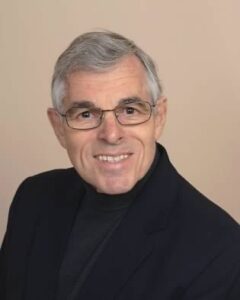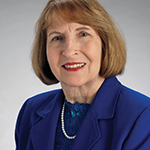Rheumatologists who are outstanding clinicians, provide consistently exceptional care to patients and serve as role models for colleagues and trainees are in the spotlight in our Lessons from a Master Clinician series. Here, we offer insights from clinicians who have achieved a level of distinction in the field of rheumatology.
Gary Hoffman, MD, MS, MACR, is a professor of medicine at the Cleveland Clinic. After beginning his career at Dartmouth-Hitchcock Medical Center, Lebanon, N.H., in the U.S. Army and at the Mary Imogene Bassett Hospital, Cooperstown, N.Y., he joined Anthony S. Fauci, MD, director of the National Institute of Allergy and Infectious Diseases (NIAID), at the National Institutes of Health (NIH) as the head of the Vasculitis and Related Diseases Section from 1986–92.
In 1992, Dr. Hoffman became chair of the Department of Rheumatic and Immunologic Diseases (1992–2008) at the Cleveland Clinic, where he held the Harold C. Schott Endowed Chair. He is the founder of the Cleveland Clinic Center for Vasculitis Care and Research, founder and past chair of the International Network for the Study of the Systemic Vasculitides (INSSYS) and professor emeritus of medicine at the Cleveland Clinic Lerner College of Medicine.
He has led investigations of new therapies for vasculitis and coordinated INSSYS-based multi-center studies of diagnostic laboratory and imaging tools to assess vasculitis disease activity.
He has received the NIH Director’s Award, the NIAID Director’s Award, Wegener’s Foundation Award, the William Ischmael Award, the Pemberton Award, the Ira Goldstein Memorial Lecture Award (NYU), the Sam and Maria Miller Award for excellence in clinical research and others.
Dr. Hoffman is a former ACR Board member, was the 2010 ACR Distinguished Clinical Investigator and is a Master of the ACR.
The Rheumatologist (TR): In your opinion, what makes for a master clinician?
GH: I don’t know about master, but anyone entrusted with another’s healthcare has responsibilities I hope we all embrace: lifelong learning, curiosity, humility and a willingness to lose sleep over difficult, unsolved problems. I remember a mentor telling me, when I was a medical student: ‘It is important to not get too close to patients.’ That was terrible advice. As a patient, I want to feel close to my doctor and to know that, if my problems are unresolved, they care and will be losing sleep over me.
When I was in my residency and fellowship at Dartmouth, we had little to offer some patients with autoimmune diseases, such as progressive systemic sclerosis and even rheumatoid arthritis. Those were the days of gold injections and penicillamine, drugs that caused much toxicity and had modest, if any, benefit. Many patients in our waiting rooms had wheelchairs or other assistive devices, had scars over joints that were the objects of failed surgeries and had reason to lose hope. It was also the early days of joint replacement.
I think we have to be transparent with our patients when the answers are not certain.
Josh Burnett, MD, was my senior clinical mentor. He was the first rheumatologist in New Hampshire and among the first formally trained rheumatologists in the U.S., having spent six months at Massachusetts General Hospital. I can remember more than a few patients telling him something to the effect of, ‘Dr. Burnett, I am so sorry you have to deal with all my problems and have such poor treatment options.’ Josh was a towering, sweet man. He would hold patients’ hands, which always looked so small in his, and tell them he was there for them and would help however he could, especially for those ailments/comorbidities that could be treated more effectively. He was my hero. He was beloved and taught me more than I can express about the humanity of being a doctor.
Josh also taught me about mentoring beyond medicine. He frequently had us over for dinner and made sure to learn about the fellows with respect to our spouses, significant others, passions, problems and goals. We also learned about him and his family. These were special times that enhanced our investment in each other and I think made us a happier and more effective rheumatology division.
Josh and Edward (Ted) Harris, MD, encouraged me to spend time with surgical and rehabilitation consultants. I went to operating rooms, watched surgeries and became involved with rehabilitation, later even becoming director of a rehabilitation/physical therapy unit. These colleagues were wonderful teachers who taught me how they were helping my patients, and they also showed the limitations of their practices.
I continued that approach with surgeons for my vasculitis patients who were undergoing vascular bypass, subglottic, tubular airway and sinus surgeries. Not only did I learn, but almost without exception, whenever I called them with urgent problems, my patient and I were rewarded with prompt and friendly responses. It was so much fun! It is sad to see how little time is allowed for this kind of team relationship building in today’s ultra-busy practices.
During these years my research was all over the map, driven by patient problems that were confusing, and led to literature reviews and new questions about lupus and pregnancy, antiphospholipid antibodies, myositis, calcium oxalate arthropathy in renal failure, pelvic/musculoskeletal tumors masquerading as hip pain and septic bursitis. Not focusing on a single subject will not create a foundation for an academic career, but it made me feel like a more effective doctor, and I thoroughly enjoyed it.
Tony Fauci recruited me to join the vasculitis program at the NIH in 1986. As a clinician-investigator, now with unprecedented opportunities to collaborate with like-minded people in other specialties and basic scientists and epidemiologists, I was ecstatic. I made many friends with lab-based colleagues interested in antineutrophil cytoplasmic antibodies and mechanisms of vascular and pulmonary injury, vessel growth and differentiation, and clusters of patients with granulomatosis with polyangiitis that raised questions about environmental triggers. It was like being a kid in a candy store. I will always be grateful to Tony for hiring me and being a friend and mentor.
TR: What lessons have you learned from patients that have contributed to your own growth as a clinician?
GH: Someday, unfortunately, we will all be patients. Some of us will become victims of life-threatening diseases. When I think about patients with crippling musculoskeletal and autoimmune diseases or those with large or small vessel vasculitis, what stands out most is their resilience and courage. Most people find the will to fight, to survive and restore their lives as active students, spouses, friends and workers. I have witnessed this so many times, from children to the very elderly. It is inspiring and deserving of our respect and admiration.
TR: What skills, habits or experiences have you found most helpful in finding the right diagnosis in medical mystery cases that heretofore had been unsolved?
GH: One has to accept that, even if we are thought to be experts by our peers, our fund of knowledge is profoundly limited. Medical mysteries are not rare, whether they be a new variation on a familiar theme or, less often, an unrecognized, new disease. Fortunately, literature searches are far easier today than going to Index Medicus (some old-timers may remember that).
Depending on the pace of disease progression and severity of illness, one may or may not have time to review the literature. Depending on consultations should not be considered a sign of weakness. Under the best of circumstances, you may even want to set up a brainstorming session with colleagues. I am not hesitant to do this with colleagues at my institution or in other institutions and am always flattered when someone calls me for advice.
I recommend you pick up the phone or have a problem-solving meal with colleagues. Do not underestimate how sharing a meal, especially in your own home, can promote bonding and may solve medical mysteries.
TR: How do you approach the concept of uncertainty when entertaining a diagnosis for a patient?
GH: In medicine in general, and especially in rheumatology, uncertainty is a familiar companion. One example of uncertainty is a patient with an ‘undifferentiated’ disease-phenotype. Those are interesting situations. If the duration of illness is brief and there has been no recognized pattern of end-organ damage, patients should know that
diseases often evolve and may not present as a fully developed picture. An illness may become more obvious and dictate a specific therapy or may even regress and resolve and be self-limiting. Patients need to know this and be reassured that you (and consultants, if necessary) will be available to follow this process and change course as needed.
In the meanwhile, you will be offering symptomatic therapy and monitoring them for any new subtle, as well as serious, developments. Patients often have more pressing questions: How did I get this? Will it go away? When can I return to work? How likely is it for my children to have this? Will these meds provide remission? Can it be fatal? I think we have to be transparent with our patients when the answers are not certain. They deserve nothing less.
Jason Liebowitz, MD, completed his fellowship in rheumatology at Johns Hopkins University, Baltimore, where he also earned his medical degree. He is currently in practice with Skylands Medical Group, N.J.




